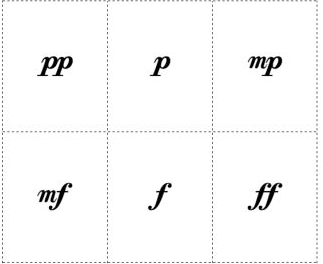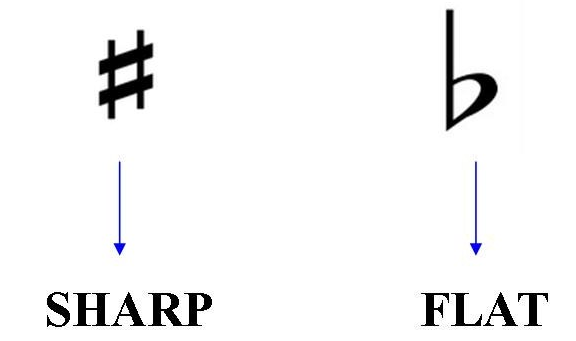In music, there are times to play loud and soft, dynamics help tell us when to do that. There are 4 major dynamics that are frequently used: piano(softly[p]), mezzopiano(medium soft[mp]), mezzoforte(medium loud[mf]), forte(loud[f]). Somtimes, pianissimo[pp] and fortissimo[ff] are also used. Pianissimo means to play very softly, while fortissimo means to play very loudly. Below is a picture of the dynamics we just discussed, and how they will appear in music. Typically, dynamic symbols are written below the music staff, and below each each to which it is apllied to. When a dynamic is written, it is to be apllied to all notes following the dynamic symbol until another dynamic symbol is written.

Accidentals:
Accidental are sharps, flats and naturals. Sharps and flats are used to signify that a note is to be played half a step higher or lower in the music staff. A sharp note is to be played half a step higher and a flat note is to be played half a step lower. You do not need to worry about what a half step is or how it sounds, but you just need to know that the note sounds different without the accidentals.

So how do we read accidentals? Once again, we need to identify the name of the note, but in addition, we need to identify the accidental. When writing notes with accidentals, we would declare the accidental first before the note. However, when reading accidentals, we would declare the note name first before the accidental. So in the example below, it would be read as F sharp.
Here is a list of all the basic possible accidentals for each note. Please keep in mind that these are not all of the accidentals covered throughtout the world of music theory, but these accidentals give you a basic understanding of the concept. Other accidentals will never be discussed in later lessons.
The Tie and The Dot Rule:
So far we have notes that represent 4 counts, 2 counts, 1 count, half a count, and even a quarter of a count. But how can we represent a note that is played for 3 counts? There are 2 ways to represent these notes: Using ties and dots. We will first explain the rule of the tie. A tie is a curved line connecting 2 of the same pitched notes like a bridge. Here's an example:

So what does this mean exactly? It's simple. The note values that are tied together are added together. So in the example above, we have a half note tied to a quarter note. So we take the note values of the tied notes, which in this case, is 2 counts and 1 count, add them together, to get a 3 count note! It's brilliant math!
There's a few things wrong with ties:
First: Ties take up too much space
Second: The use of many ties can be confused for slurs (We will probably not discuss about that ever unless we continue making lessons)
Third: Ties create a lot of "dead" notes. What we mean by this is that only the first note in a tie is played while the second one just adds its value to the first.
So what's the solution? This is where the dot rule is applied. By adding dots to a note, we can change a note's value into something else. So, how does it work? Let's consider looking at an example
We can identify that the note is a half note followed by a dot. This is called a dotted half note. A dot that follows a quarter note is called a dotted quarter note. This is how we name notes that have dots on them. The rule of the dot is this: The dot adds half the value of the previous value of music to it. Let's look at our example again. We have our initial note value of 2 beats from the half note. The dot's value is half the value of the previous value. So half of the value of the half note is 1 beat, and that 1 beat gets added to the initial note value (2 beats). So, the note in the example is played for 3 beats total. Let's look at another example.
In this example, the initial note value is 1 beat. The dot is half the value of the previous beat. Half of 1 is one half of a beat which is equivalent to the value of an eigth note. Altogether, this entire note would be played for 1 and a half beats. In order to count rhythms that are in between beats, we would say "and" in between the counts. The normal way of counting was 1 2 3 4 like we've been doing, but now, we need to also represent counts in between beats. So we would count them like this: 1 + 2 + 3 + 4 +. The plus sign represents half a beat and said as "and" when counting.